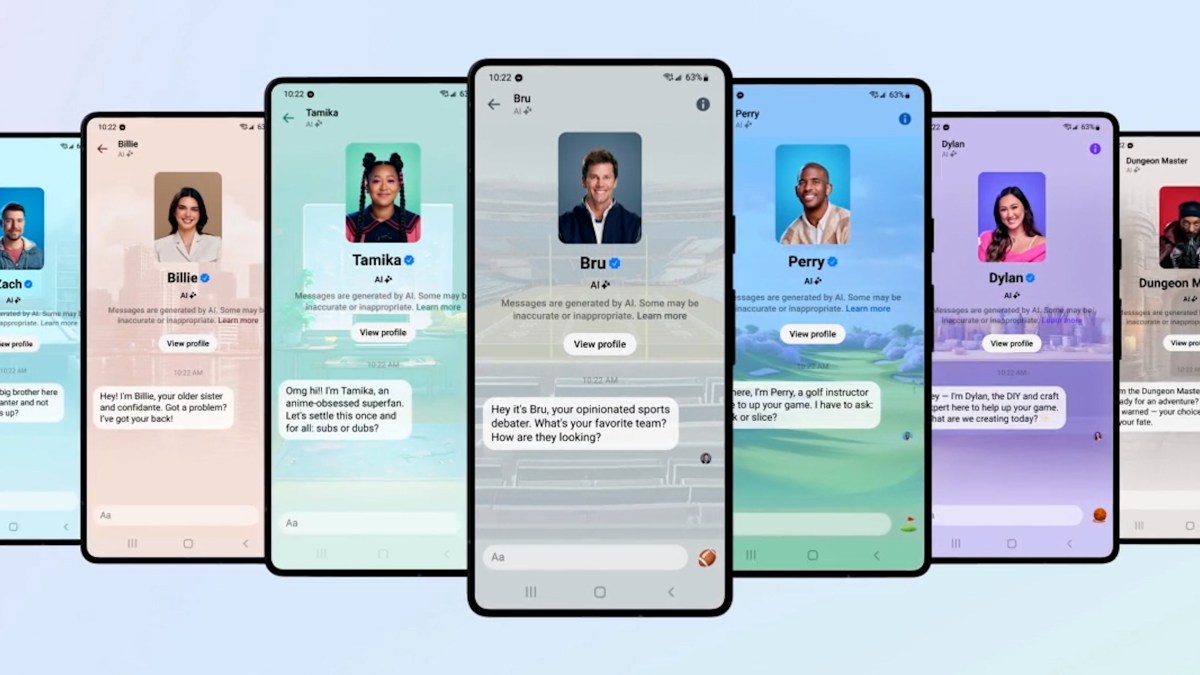Latest Thoughts
-
🧠 Meta has a New Contender in the AI Art Space
I thought personalized chatbots would be the biggest drop from Meta, but they also released an image generator named Imagine that rivals OpenAI’s DALL-E and other image generation AI tools like Midjourney and Stable Diffusion. I may be in NYC vs. Mars, but it does a pretty darn good job, check it out.

-
🧠 Meta offers Chatbots with a Personal Touch
Meta’s showing everyone it’s got some serious AI muscle with genuinely interactive chatbots, all building on Meta’s AI models like Llama and EMU for video editing. Now, the much-anticipated Meta AI characters have arrived, complete with unique personalities, ready for a chit-chat about anything that’s on your mind.
But hold onto your hats, because here’s the wild part:
“In addition, the company said more of its AI characters will support search powered by Bing and it will begin experimenting with “long-term memory” in several — meaning, the characters will learn and remember your conversation when it’s over.”
We’re stepping out of the ephemeral chat bubble and into a world where recollections create connections. Long-term memory in chatbots? It’s a brave new world of continuity and context, folks.
-
🧠 Is Digital Ownership a Raw Deal?
The fine print in those terms we breezily accept turns out to be a bigger deal than we thought—it’s giving us a lease on our digital stuff, not real ownership. When you pick up a digital movie, music, or game, it’s all tangled up in some complex licensing deal that could make your stuff just stop working or disappear.
Remember when owning a CD or a DVD felt solid? Well, even those good old physical copies are no longer a sure bet. Today’s video games are a prime example; they land in our hands unfinished requiring huge downloads and bug us with updates and digital checks just to play.
And it’s not just entertainment. Our houses are filled with ‘smart’ things—lights, locks, and other gadgets—that rely on costly online services. And we’ve all seen what happens when those services go dark—the stuff we paid for turns into expensive bricks.
So what’s really yours today? If the internet suddenly went poof, a lot of our tech would just be expensive paperweights. I guess you could always curl up with a good book—just make sure it’s not on an e-reader.
-
🧠 App Stores are keeping us from the next evolution of gaming, subscriptions
It’s obvious at this point that the future of gaming is not consoles but subscription-based gaming platforms, each with tentpole or exclusive content. We have long proved that even the heaviest games can stream over the Internet and run on limited terminals without the bulk and power of expensive consoles with features like Xbox Remote Play.
These days, Netflix features games above most shows and movies. Xbox, PlayStation, and Nintendo offer monthly “game passes” full of content and quarterly exclusive drops. Apple long ago moved to subscription games with its arcade product.
The big question is how long before the Apple AppStore and Google Play store concede to allow these game platforms a place – even if it directly competes with them or erodes the stickiness within their ivy walls – to provide a native gaming experience for the big console companies. After all Microsoft has tried and failed to offer a first-party native app.
As flawed as Epic’s lawsuit has felt, this seems like the real issue and heart of the coming war unless gaming companies and platforms can find a way to work together.
-
🧠 OpenAI’s drama comes to an end
Popcorn lovers rejoice the shortage is over as the long OpenAI drama that began with the sudden firing of CEO Sam Altman, two interim CEOs, Microsoft starting a new division and hiring Altman, has finally ended with a new board and Altman back as CEO. If you plan to skip the link article, this is the most significant bit:
“In a letter circulated internally at OpenAI and subsequently published to the OpenAI blog, Altman announced that Mira Murati, who was briefly appointed interim CEO by the previous board, will return to her role as CTO, and confirmed that the initial new board will consist of Bret Taylor, the former co-CEO of Salesforce; Quora CEO D’Angelo, who served on the previous board; and economist and political veteran Larry Summers. Microsoft will also gain representation on the board in the form of a non-voting observer.”
-
🧠 Embrace iPhone’s NameDrop
I’m a bit of an oddball, constantly running beta versions of iOS (and Android) year-round. So, when the latest release hits, the new features are old news to me. However, every now and then, something I’ve been using nonchalantly catches me off guard—in this case, Apple’s new NameDrop feature, which I happen to love.
NameDrop lets you effortlessly share your contact information with another iPhone by bringing two unlocked phones in close proximity. It’s a far superior alternative to the awkward dance of scanning each other’s LinkedIn QR codes at a networking event. You have control over how much information you share, allowing you to conceal personal emails or phone numbers. Plus, you can even choose a poster screen or a picture to represent yourself.
Interestingly, some police departments got a bit jittery about the idea of strangers getting hold of your personal details, but truth be told, it’s quite safe and not much different from exchanging a business card. If the paranoia still lingers, the linked article provides details on how to turn it off.
Give it a shot, especially if you often find yourself out and about, navigating the networking scene.
-
🧠 Keys? So last year
For my 2023 tech resolution, I was determined to free my pockets from the jingle-jangle of keys, and folks, I’m thrilled to announce that I’m now proudly keyless. I kicked things off by upgrading the locks on my house, opting for smart locks like Yale and Level+—they still play nice with a physical key but graciously respond to Apple’s Home Key, activated with a simple tap of my watch or phone.
The car key situation seemed like a tougher nut to crack, even with more cars embracing mobile app unlocking and Apple teasing limited car key support. But lo and behold, Tesla’s keyless control, automatically unlocking when I’m in close proximity, turned out to be the game-changer I needed.
Look ya’ll, it’s time to bid farewell to the era of keys. Digital keys aren’t just the future; they feel like the future, and when they do their thing, it’s downright magical. No more fumbling through pockets, bags, or purses—stroll up, and voila, it knows and unlocks. I’m eagerly anticipating the day when standardization lets all of us drop those stabby metal objects from our pockets. Bring on the digital key revolution!
-
🧠 What spooked OpenAI’s board?
Sam Altman is back as CEO of OpenAI after four board members of the nonprofit that runs the AI company attempted a poorly planned coup. Much of this drama played out over an intense Thanksgiving holiday — and if you missed it, I highly suggest you check out last week’s newsletter.
As the OpenAI coup story ends (or begins), one huge question remains: What did the OpenAI board learn that spooked them enough to destroy one of the most important companies and innovations ever created? Some think it may have been an internal project named Q* (pronounced q star), led by now-former board member and Chief Science Officer Ilya Sutskever, that allows AI to solve math problems.
If so, here’s my take: AI as we know it is amazing but falls short of being considered a true AGI or an artificial general intelligence. Many current models are LLMs or large language models that can predict the next word in a string, but they don’t truly think or solve logic problems on their own – they’re reliant on answers that already exist. Solving math and solving it in novel ways, takes great problem-solving ability that this q* project may have shown.
If that’s the case, then a well-funded group could build an AI that can access and interpret more data than a human ever could with the processing power to solve unknown math problems. A system that can do that could solve cryptographic and encryption problems that require quantum computing.
This is all conjecture and rumor for now, but something clearly spooked this board enough to take potentially career-ending measures to slow down the progress of AI.
Maybe we’ll eventually hear the full OpenAI story and what truly sparked such dissent. But one thing is clear – AI has the potential to be the most important innovation since electricity, a stunningly transformational breakthrough that could change the course of mankind. The question is, should we tap the brakes or push forward full speed ahead? I say keep the pedal to the metal, what say you?
/cloudfront-us-east-2.images.arcpublishing.com/reuters/WRAGM7C3ONP4BO5NMF23ZGV2SA.jpg) OpenAI researchers warned board of AI breakthrough ahead of CEO ouster, sources sayAhead of OpenAI CEO Sam Altman’s four days in exile, several staff researchers wrote a letter to the board of directors warning of a powerful artificial intelligence discovery that they said could threaten humanity, two people familiar with the matter told Reuters.
OpenAI researchers warned board of AI breakthrough ahead of CEO ouster, sources sayAhead of OpenAI CEO Sam Altman’s four days in exile, several staff researchers wrote a letter to the board of directors warning of a powerful artificial intelligence discovery that they said could threaten humanity, two people familiar with the matter told Reuters. -
🧠 What is happening at OpenAI‽
Executives get the axe all the time, but these are usually very coordinated events with press releases, company all hands, and well-crafted letters to customers and partners. Open AI did none of that, leaving us all assuming the worst.
So far, we know Sam Altman, CEO and Co-founder, was fired on the same day Greg Brockman, the other co-founder and board member, resigned from the board. That could be because of a disagreement, but the OpenAI board felt it necessary to announce this 30 minutes before markets closed while giving its billion-dollar partner Microsoft only a 5-10-minute heads-up.
Maybe in a week or two, between leaks and insider journalist reports, we’ll have some idea, but this is a huge decision for a high-rolling start-up (even if it’s a non-profit) that has the entire world watching. I hope the “crime” fits the punishment.
In the meantime, for those of us using OpenAI’s products, does this shake your confidence in the company? I’m personally cautious, but I want to know if this is due to more significant security, copyright, or privacy issues.
-
🧠 Hotel showers are surprisingly bad
The nicer the hotel shower, the less functional it appears to be. I travel and have traveled a lot in my career, and the hotel bathroom is consistently bad, with a shower or tub that feels designed to create a flood.
Until reading this article, I thought I was alone with my thoughts on the many confusing showers I’ve used, but it looks like I’m not. The worst are half-glass or partially enclosed showers that for some reason all suffer from a weirdly placed drain or a basin that is tilted to flood the bathroom floor.
While we’re talking hotel bathrooms, I hate the new trend of giant bottles of soap, shampoo, and conditioner glued or bolted to the wall so they’re cleaned by the shower’s steam. Those things suck.
-
🧠 Go try Meta’s Emu Video
Meta released a blog on its internal research products Emu Video and Emu Edit, two new forms of generative AI that can create new videos or edit videos and images from a prompt, and it’s impressive. The link below limits us to preselected prompts but demonstrates how much is possible with just a thought or idea. Check it out!
-
🧠 Is Google just that good?
Four years ago, I switched to Duck Duck Go as my default search engine, and it does a fantastic job for 95% of my searches. For the last 5% of searches, I try Google, and I’m often surprised to find its results to be about the same and, in several cases, the overall Google experience to be much worse.
Maybe I feel jaded by Google’s shift from clear, concise results to a revenue-focused devolution of its UX, with the upper third of search results covered in ads, tons of sponsored links, giant login boxes, and unhelpful shopping suggestions, but I find it hard to say Google is the truly superior product.
Your view may differ, but the heart of Mike Masnik’s article is how you would punish Google if it is found to be a search monopoly, especially if its fault is building a product that’s so good others can’t match it.
-
🧠 EV Chargers continue to be a problem
Joanna Stern has an excellent article in the Wall Street Journal. In it, Stern chronicles 48 hours in a Rivian R1T, stopping at over 120 non-Tesla EV chargers, and 40% had issues. Stern categorizes the problems into 3 categories: chargers out of order, chargers that failed to accept payments, and chargers that experienced “handshake” issues when communicating between the charger and EV.
The unevenness of the charging experience drove me to buy a Tesla over other EVs, and every time I attempt to use a different EV charger, I’m reminded of how great of a decision that was. Just two weeks ago, I stayed at a hotel with EV chargers in the parking garage, and try as I might, the darn things didn’t work.
EV chargers are a mess and will continue to hold back EV car adoption.
-
🧠 The Last Airbender looks gorgeous
After the horrible attempt at a movie, I’ve kept my excitement for this real-life remake on ice, but this trailer looks fantastic. Something about it gives me hope that the producers loved the cartoon and got what makes it tick.
I think I’ll know for sure when I hear “My Cabbages!”. Feb 22, I can’t wait.
-
🧠 Real estate commissions lawsuit opens the door for tech disruption
MLS, or the Multiple Listing Service, is how we all search and find home listings. Regardless of what reality website you might use, they consume their hosing data from MLS.
At the heart of this lawsuit are commissions, and commission sharing is required to list or get access to the MLS listings. This makes it nearly impossible for an individual to list his or her home on the MLS (and virtually every existing real estate website) without agreeing to pay a commission or becoming a licensed realtor.
It will take years between appeals before this case is truly resolved, but it stands to upend how realtors are currently paid and further open the door to tech disruption. If this stands, the marketplace could make it easier for folks like you and me to list a house and sell it directly to another person on an exchange, saving 3-6% in commissions from closing costs. It could also shake up how real estate agents are paid, changing how they work,
This is definitely a place to watch…
-
🧠 Chamberlain is making a huge mistake
One of my first smart home purchases was the Chamberlain MyQ smart garage door opener, and for one year, it was clunky but did the job. Eventually, the battery in one of its sensors died. It took me a week to find and order a new replacement battery, and from that day on, the integrations with HomeKit stopped working, and my constant calls for support fell on deaf ears.
Without HomeKit, the product sucked. What made it great was that CarPlay intuitively suggested I wanted to open the garage door when I neared my house, opening the door from my watch in two taps when taking out the garage, or asking Siri (and then authenticating on my phone). Better yet, I could chain together automation to turn on the garage lights when I open the door after sunset and to unlock the associated garage door.
It’s obvious Chamberlain is clueless about smart homes, and today, it is making its product less helpful by breaking with a growing ecosystem of interconnected smart home devices. Even if its bet is to integrate with cars instead of Amazon, Google, or Apple’s growing ecosystem, it seems like they still need to remember that the lion’s share of drivers would happily abandon their horrible car interfaces for Android Auto or Apple CarPlay.
This is frankly a dumb move, and it makes me happy I trashed my MyQ for a Meross Garage Door Opener that works MUCH MUCH better than without batteries and a costly hub.
Do yourself a favor and trash the Chamberlain for a product that gets it.



/cdn.vox-cdn.com/uploads/chorus_asset/file/22015304/vpavic_4278_20201030_0247.jpg)



/cdn.vox-cdn.com/uploads/chorus_asset/file/25114965/P90354782_highRes_bmw_digital_key_06_2.jpg)





/cdn.vox-cdn.com/uploads/chorus_asset/file/25072175/en_US_atla_main_appa_4_x_5__v__1080px1350p_rgb_pre_1.jpg)

